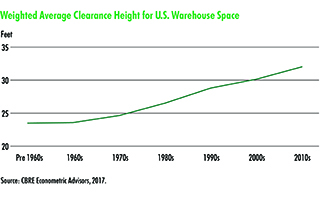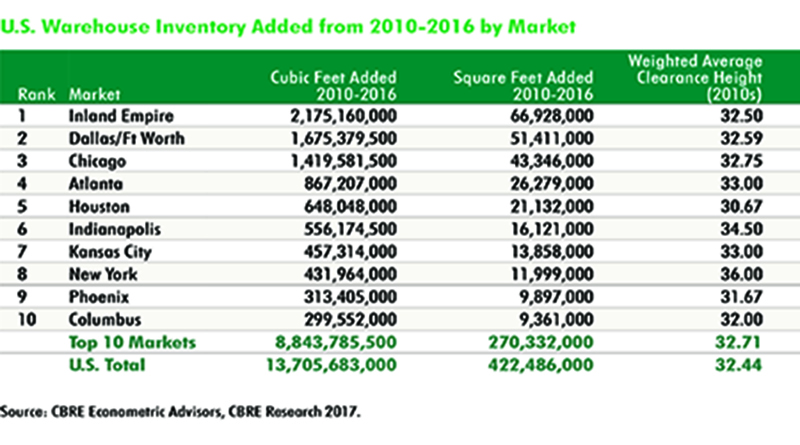 CBRE Data Shows Phoenix Added More than 313M Cubic Feet of Warehouse Space Since 2010
CBRE Data Shows Phoenix Added More than 313M Cubic Feet of Warehouse Space Since 2010
Phoenix, Arizona – The rapid growth of e-commerce fulfillment networks in recent years has resulted in a steady increase in the height and volume of warehouses and distribution centers, likely necessitating a shift to three-dimensional measurement of industrial space, according to a new research report from CBRE Group, Inc.
The average height of warehouses built in the U.S. has steadily risen from roughly 24 feet in the 1960s to 32.4 feet this decade (33 feet in 2016). E-commerce companies have made use of that additional vertical space by installing mezzanine levels, allowing them to add more human inventory pickers in each building.
Such mezzanine levels aren’t typically included in measures of a property’s or market’s industrial square footage. Thus, measuring cubic footage might be the better way to examine the full extent of warehouse and distribution-center space.
CBRE data shows that 13.7 billion cubic feet of warehouse space was built in the U.S. from 2010 to 2016, with 65 percent of that total coming in the 10 largest markets, led by California’s Inland Empire, Dallas/Fort Worth and Chicago. Phoenix also ranks among the 10 largest markets for warehouse growth, adding over 313 million cubic feet of warehouse space with an average warehouse height of 31.67 feet during this same period.
“E-commerce is driving three major trends in building design: separate car parking that is segregated from truck areas, taller clear height, and queuing lanes for controlled access into secured truck/trailer storage areas,” said Pat Feeney, an industrial specialist with CBRE’s Phoenix office. “Given the continued strength of Phoenix’s industrial sector, the market is well-positioned to accommodate these types of changes as investors continue to seek out Phoenix for warehouse space.”
Nationally, warehouse space built since 2010 amounts to only 422.5-million-square-feet when measured by ground-level floor area. But far more than that is being used.
“There’s an argument to be made that industrial space should be talked about on a volume basis, not an area basis, because that space above the floor is very important,” said David Egan, CBRE Head of Industrial & Logistics Research in the Americas. “It’s key for labor-intensive users like e-commerce companies, which can put more racks and employees in that additional workable space.”
To view the report and data tables, click here.



